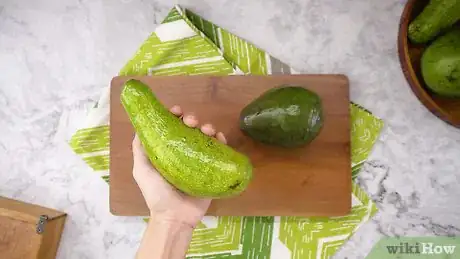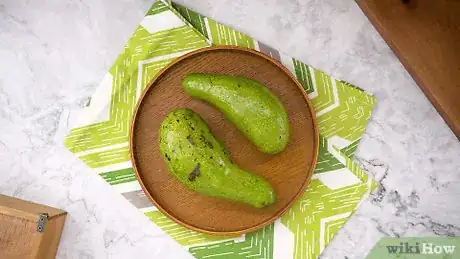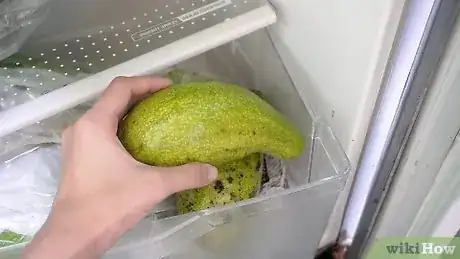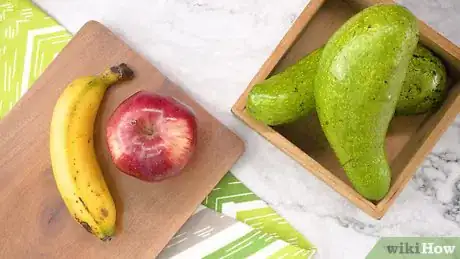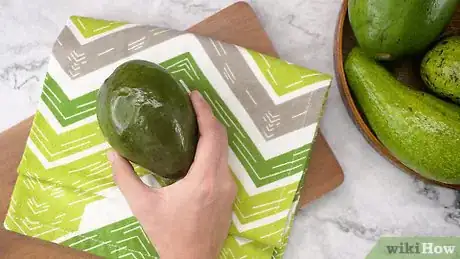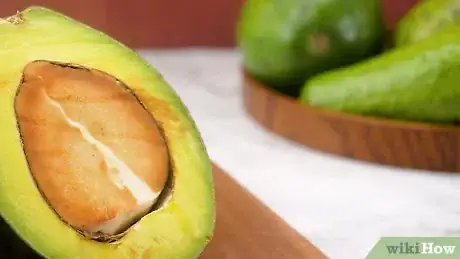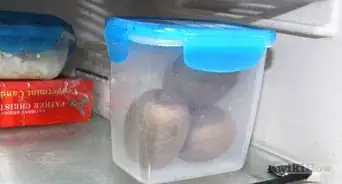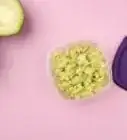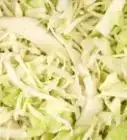This article was co-authored by wikiHow Staff. Our trained team of editors and researchers validate articles for accuracy and comprehensiveness. wikiHow's Content Management Team carefully monitors the work from our editorial staff to ensure that each article is backed by trusted research and meets our high quality standards.
The wikiHow Video Team also followed the article's instructions and verified that they work.
This article has been viewed 39,627 times.
Learn more...
Avocados can make a rich addition to sweet and savory dishes due to their high fat content and their creamy texture. Their window of ripeness is also notoriously short. Once you find a perfectly ripe avocado, you can extend its life by storing it in the fridge. Or, you can puree and freeze the flesh. Either is an easy way to maximize your enjoyment of fresh, ripe avocados.
Steps
Storing Unripe Avocados Properly
-
1Identify an unripe avocado by lighter skin color and firm exterior. A dark avocado, with nearly black skin, is more likely to be ripe, while a bright green avocado will be unripe. Cradle the avocado in your palm and squeeze lightly. Don't grip the avocado with your fingertips. If you squeeze too hard, you can bruise the flesh. Unripe avocados will feel hard, and won't give at all.[1]
-
2Store unripe avocados on the counter for 4-5 days. Avocados will ripen at room temperature on your countertop. This allows the skin to breathe, and is the most natural way for avocados to ripen. Once the avocado is ripe, eat it within 1-2 days.[4]Advertisement
-
3Preserve an unripe avocado in the fridge for up to 2 weeks. Place the avocado in the produce bin of your fridge. This will cause the ripening process to slow down considerably, meaning your avocados will stay fresh for up to 2 weeks.[5]
-
4Take an unripe avocado out of the fridge 2 days before you want to eat it. Avocados ripen very slowly in the cold. Once an avocado has been refrigerated, bring it to room temperature and allow it to fully ripen before eating it.[6]
- If you'd like to speed up the ripening process once you remove the avocado from the fridge, put it in a paper bag or place it next to an ethylene producer like a banana.[7]
-
5Keep unripe avocados away from bananas and apples. If you find that avocados are ripening or spoiling too quickly, place them away from ethylene-releasing fruits like bananas and apples. Storing these fruits together will cause them to spoil more quickly.[8]
- Other ethylene producers include cantaloupe, kiwi, peaches, pears, peppers, and tomatoes.[9]
Refrigerating or Freezing Ripe Avocados
-
1Identify a ripe avocado by its dark color and soft texture. Look for dark green, nearly black skin as a sign of ripeness. Ripe avocados will give in to pressure when you squeeze lightly. The firmness will feel similar to pressing your fingertips into your scalp.[10]
- Avoid mushy avocados. If you pick up an avocado and the flesh is soft, or if you can see dents in the surface, the avocado is most likely overripe or bruised.
-
2Preserve a ripe avocado in the fridge for up to 3 days. If you would like to keep an avocado at optimal ripeness for a few extra days, place it whole in your fridge. This will keep it ripe for an extra 2-3 days. When you are ready to eat it, put the avocado on the counter and allow it to come to room temperature.[11]
-
3Preserve part of a ripe avocado with lemon juice and plastic wrap in the fridge. If you've already eaten part of a ripe avocado and want to keep the other half from becoming overripe, first rub a little bit of citrus juice on the surface of the flesh. This will keep it from turning brown. Then, cover the avocado tightly with plastic wrap. Store the wrapped avocado in the fridge for a day or two.[12]
- Any acidic juice will work to preserve a partial avocado, but lemon or lime will taste good with a wide variety of sweet or savory recipes when you are ready to use the other half.
-
4Leave the pit in the uneaten part of a ripe avocado. The pit won't technically keep the avocado from becoming overripe. However, it acts as a barrier and prevents oxygen from reaching the inside of the avocado, keeping it fresh and green.[13]
-
5Store pureed ripe avocado flesh in the freezer. Avocado puree can be frozen for several months. Mash the flesh with a fork or a food processor, then add 1 tablespoon (15 mL) lemon or lime juice per avocado. Add the puree to a freezer-weight, resealable bag, squeeze out the air, and close the bag. When you are ready to use the avocado, thaw it in the fridge or on the counter.[14]
- Freezing avocado will change the texture, but will still work for making things like guacamole or smoothies that call for pureed avocado.
References
- ↑ https://www.epicurious.com/ingredients/how-to-buy-and-store-avocados-article
- ↑ https://www.epicurious.com/ingredients/how-to-buy-and-store-avocados-article
- ↑ https://www.epicurious.com/ingredients/how-to-buy-and-store-avocados-article
- ↑ https://www.cookinglight.com/cooking-101/techniques/how-to-keep-avocados-going-bad-turning-brown
- ↑ https://whatscookingamerica.net/avocado.htm
- ↑ https://whatscookingamerica.net/avocado.htm
- ↑ https://lifehacker.com/store-avocados-in-the-fridge-to-keep-them-from-over-rip-5818806
- ↑ https://www.cookinglight.com/cooking-101/techniques/how-to-keep-avocados-going-bad-turning-brown
- ↑ https://ucsdcommunityhealth.org/wp-content/uploads/2017/09/ethylene.pdf
- ↑ https://www.cookinglight.com/cooking-101/techniques/how-to-keep-avocados-going-bad-turning-brown
- ↑ https://whatscookingamerica.net/avocado.htm
- ↑ https://www.cookinglight.com/cooking-101/techniques/how-to-keep-avocados-going-bad-turning-brown
- ↑ https://www.cookinglight.com/cooking-101/techniques/how-to-keep-avocados-going-bad-turning-brown
- ↑ https://whatscookingamerica.net/avocado.htm
